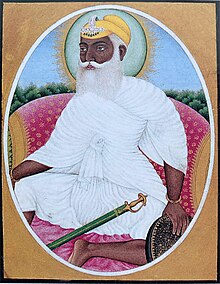Ala Singh (1691–1765) was the first king of the princely state of Patiala.[1][2]
Ala Singh | |
|---|---|
 | |
| Maharaja of Patiala | |
| Succeeded by | Maharaja Amar Singh |
| Personal details | |
| Born | 1691 Phul |
| Died | 1765 |
| Children | Sardaul Singh, Bumian Singh, Lal Singh |
| Parent | Chowdari Ram Singh |
Biography edit
He was born in 1691 at Phul, in present-day Bathinda district of the Punjab, in a Jat Sikh family to Chaudhary Ram Singh of Phulkian Misl.[3] His father had six children, from eldest to youngest Dunna, Subha, Ala, Bakha, Budha, Ludha. The Chowdhriat of the Misl had been originally conferred on his ancestor Brahm by Babur, after the First battle of Panipat in 1526 A.D.[4]
During the Vadda Ghalughara in April 1762, Ala Singh failed to assist his religious kin.[5] He stayed neutral during the events and did not initiate hostilities against the Durranis.[5] However, this neutralitity would not save Ala Singh as Abdali, whom had been told that Ala Singh was a "secret ally of the Majhi Sikhs" by Zain Khan and Bikhan Khan, would later burn down Barnala and advanced upon Bhawanigarh, where Ala Singh was holed up.[5] Ala Singh sought out the help of Najib-ud-Daula and was forced to pay a humiliating fee of "five lakhs of rupees as tribute and a hundred and twenty-five thousand rupees more for permission to appear before him with his long hair intact" to placate Abdali.[5] After this, Ala Singh was detained for a short-while but was released on the promise that his polity would pay an annual tribute to the Durranis.[5]
Ahmad Shah Durani attacked Barnala in the absence of the Maharaja, when he was at Moonak. He forced the Maharaja to pay Rs. four lacs, out of which only Rs. fifty thousand were paid. The Durani King conferred upon him the title of "Raja" and granted him an area comprising 727 villages. Ala Singh at the age of 57, in 1763 A.D., laid the foundation of the city of Patiala. In the same year heading the Sikh confederacy he conquered Sirhind and surrounding territories along with Nanu Singh Saini.
Death and succession edit
He died in 1765, leaving the gaddi to his grandson Maharaja Amar Singh, his three sons having predeceased him. Sardaul Singh the eldest died in 1753, Bhumian Singh died in 1742 and Lal Singh the youngest died in 1748.[6]
Gallery edit
-
Letter written by Baba Ala Singh of Patiala
-
Darbar of Baba Ala Singh in Patiala
-
“Maharaja Ala Singh, founder of Patiala state ruled still A.D. 1765” from a set of portraits of six maharajas (rulers) of Patiala State, late 19th century
References edit
- ^ "Sikh people". Archived from the original on 15 July 2016. Retrieved 24 July 2016.
- ^ "Kingdoms of South Asia – Indian Kingdom of the Jat Sikhs". Retrieved 24 July 2016.
- ^ Singh, Ravneet (28 November 2018). "Historian spots tomb of Ala Singh's father". The Tribune.
- ^ SIngh, Sardar Arjan Shah (1931). "Census Report of Patiala State" (PDF). Punjab State Gazetteer: viii.
- ^ a b c d e Singh, Teja; Singh, Ganda (2006). "Sixth invasion of Durrani and second Holocaust". A Short History of the Sikhs. Vol. 1 (1469–1765). Publication Bureau of Punjabi University, Patiala. pp. 162–164. ISBN 8173800073.
- ^ Singh, Sardar Arjan Shah (1931). "'History' in Census Report of The Patiala State" (PDF). Punjab State Gazzeteer: ix.
Further reading edit
- Singh, Kirpal (2005). Baba Ala Singh : founder of Patiala kingdom (2nd ed.). Amritsar: Guru Nanak Dev University. ISBN 8177701053. Retrieved 24 July 2016.